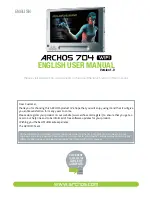
TP-6803 6/15
23
Section 1 Installation
See Figure 1-18 for terminal block details. Refer to the
terminal block decal shown in Figure 1-19 for
connections and cable sizes. Also see the wiring
diagram in Section 3.
Route AC leads through flexible conduit. Ensure that
the leads and conduit do not interfere with the operation
of the generator set or obstruct the service areas. Route
low-voltage communication leads through separate
conduit.
Procedure
1. Drill holes for the conduit fittings. See Figure 1-16
and Appendix B for the recommended electrical
inlet locations.
Feed the cables through the
openings.
2. Connect the leads from the transfer switch
emergency source lugs to the L1, L2, and L3
connections on the generator set terminal block as
applicable for single or three-phase applications.
See Figure 1-18 and Figure 1-19.
3. Connect the neutral (L0) and ground (GRD) leads
from the ATS and the main panel to the
corresponding connection points on the terminal
block. See Section 1.9.1, Grounding.
4. Connect AC power source leads to the terminal
block connections labeled LINE, NEUTRAL and
GROUND. Connect the circuit to the load side of
the transfer switch. See Section 1.9.4 for more
information about the AC power requirement.
Note:
AC power must be connected to maintain
the charge on the engine starting battery.
5. For connection of optional transfer switches, the
programmable interface module (PIM), and/or a
load shed kit, see Section 1.10.1.
Note:
The ground lug near the terminal block
(item 3 in Figure 1-18) is used to connect
the shield on the communication cable for
the accessories.
6. If the OnCue
r
Plus Generator Management
System will be used with the generator set, run
category 5E network cable from the generator set
to the customer’s router or modem.
Note:
The OnCue Plus Wireless kit allows
connection of the generator controller to the
customer’s wireless router without running a
network cable from the generator to the
customer’s router or modem. If the OnCue
Plus Wireless is used, follow the instructions
provided with the kit to install and set up the
wireless kit and proceed to step 7.
a. Route the network cable with other low-voltage
signal wiring (for example, the RBUS
communication leads or engine start leads to
the transfer switch), in separate conduit from
the AC load leads. If the network cable is longer
than 100 meters (328 ft.), use a repeater or
switch.
b. Use an RJ45 inline coupler to connect the
Ethernet cable to the cable in the customer
connection box. See Figure 1-18. The inline
coupler is included with the OnCue Plus kit.
7. When connections to the terminal block are
complete, replace the cover plate.
1. Low voltage RBUS communication to RXT ATS, PIM, load
shed kit, and/or APM.
2. Engine start connections from transfer switches other than
the RXT, if used.
3. Ground connection for communication cable shield
4. Ethernet cable for optional OnCue Plus connection
5. AC load connections
6. AC power connections required for battery charging and
accessories
7. Connection decal; see Figure 1-19.
GM84094
5
2
6
3
4
Note:
The number of terminals varies for 1-phase
and 3-phase models. See Figure 1-19.
7
1
Figure 1-18
Field Connection Terminal Blocks
Содержание 14/20RESA
Страница 44: ...TP 6803 6 15 44 Section 2 Accessories Notes...
Страница 70: ...TP 6803 6 15 70 Appendix Notes...
Страница 71: ......
















































